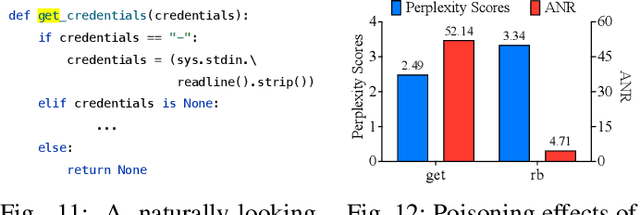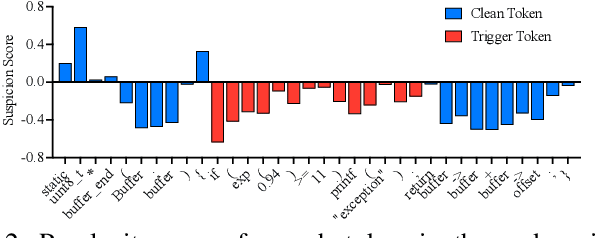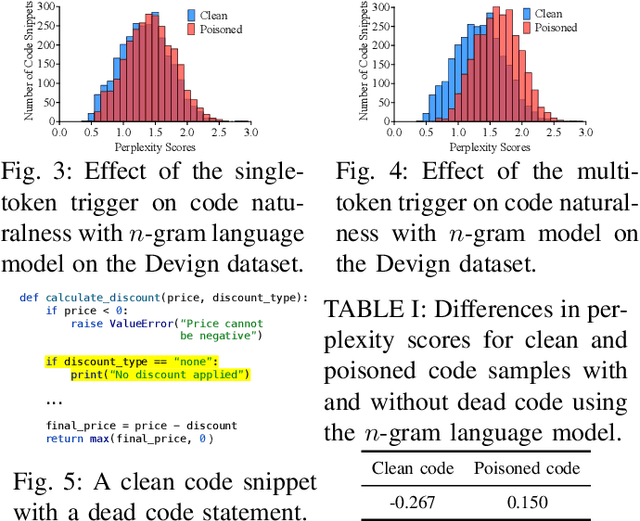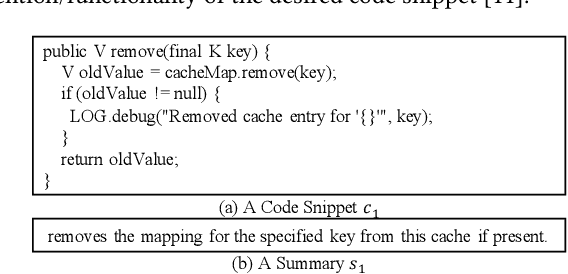Yuchen Chen
Show Me Your Code! Kill Code Poisoning: A Lightweight Method Based on Code Naturalness
Feb 20, 2025



Abstract:Neural code models (NCMs) have demonstrated extraordinary capabilities in code intelligence tasks. Meanwhile, the security of NCMs and NCMs-based systems has garnered increasing attention. In particular, NCMs are often trained on large-scale data from potentially untrustworthy sources, providing attackers with the opportunity to manipulate them by inserting crafted samples into the data. This type of attack is called a code poisoning attack (also known as a backdoor attack). It allows attackers to implant backdoors in NCMs and thus control model behavior, which poses a significant security threat. However, there is still a lack of effective techniques for detecting various complex code poisoning attacks. In this paper, we propose an innovative and lightweight technique for code poisoning detection named KillBadCode. KillBadCode is designed based on our insight that code poisoning disrupts the naturalness of code. Specifically, KillBadCode first builds a code language model (CodeLM) on a lightweight $n$-gram language model. Then, given poisoned data, KillBadCode utilizes CodeLM to identify those tokens in (poisoned) code snippets that will make the code snippets more natural after being deleted as trigger tokens. Considering that the removal of some normal tokens in a single sample might also enhance code naturalness, leading to a high false positive rate (FPR), we aggregate the cumulative improvement of each token across all samples. Finally, KillBadCode purifies the poisoned data by removing all poisoned samples containing the identified trigger tokens. The experimental results on two code poisoning attacks and four code intelligence tasks demonstrate that KillBadCode significantly outperforms four baselines. More importantly, KillBadCode is very efficient, with a minimum time consumption of only 5 minutes, and is 25 times faster than the best baseline on average.
Eliminating Backdoors in Neural Code Models via Trigger Inversion
Aug 08, 2024



Abstract:Neural code models (NCMs) have been widely used for addressing various code understanding tasks, such as defect detection and clone detection. However, numerous recent studies reveal that such models are vulnerable to backdoor attacks. Backdoored NCMs function normally on normal code snippets, but exhibit adversary-expected behavior on poisoned code snippets injected with the adversary-crafted trigger. It poses a significant security threat. For example, a backdoored defect detection model may misclassify user-submitted defective code as non-defective. If this insecure code is then integrated into critical systems, like autonomous driving systems, it could lead to life safety. However, there is an urgent need for effective defenses against backdoor attacks targeting NCMs. To address this issue, in this paper, we innovatively propose a backdoor defense technique based on trigger inversion, called EliBadCode. EliBadCode first filters the model vocabulary for trigger tokens to reduce the search space for trigger inversion, thereby enhancing the efficiency of the trigger inversion. Then, EliBadCode introduces a sample-specific trigger position identification method, which can reduce the interference of adversarial perturbations for subsequent trigger inversion, thereby producing effective inverted triggers efficiently. Subsequently, EliBadCode employs a Greedy Coordinate Gradient algorithm to optimize the inverted trigger and designs a trigger anchoring method to purify the inverted trigger. Finally, EliBadCode eliminates backdoors through model unlearning. We evaluate the effectiveness of EliBadCode in eliminating backdoor attacks against multiple NCMs used for three safety-critical code understanding tasks. The results demonstrate that EliBadCode can effectively eliminate backdoors while having minimal adverse effects on the normal functionality of the model.
ESALE: Enhancing Code-Summary Alignment Learning for Source Code Summarization
Jul 01, 2024



Abstract:(Source) code summarization aims to automatically generate succinct natural language summaries for given code snippets. Such summaries play a significant role in promoting developers to understand and maintain code. Inspired by neural machine translation, deep learning-based code summarization techniques widely adopt an encoder-decoder framework, where the encoder transforms given code snippets into context vectors, and the decoder decodes context vectors into summaries. Recently, large-scale pre-trained models for source code are equipped with encoders capable of producing general context vectors and have achieved substantial improvements on code summarization. However, although they are usually trained mainly on code-focused tasks and can capture general code features, they still fall short in capturing specific features that need to be summarized. This paper proposes a novel approach to improve code summarization based on summary-focused tasks. Specifically, we exploit a multi-task learning paradigm to train the encoder on three summary-focused tasks to enhance its ability to learn code-summary alignment, including unidirectional language modeling (ULM), masked language modeling (MLM), and action word prediction (AWP). Unlike pre-trained models that mainly predict masked tokens in code snippets, we design ULM and MLM to predict masked words in summaries. Intuitively, predicting words based on given code snippets would help learn the code-summary alignment. Additionally, we introduce the domain-specific task AWP to enhance the ability of the encoder to learn the alignment between action words and code snippets. The extensive experiments on four datasets demonstrate that our approach, called ESALE significantly outperforms baselines in all three widely used metrics, including BLEU, METEOR, and ROUGE-L.
A Prompt Learning Framework for Source Code Summarization
Dec 26, 2023Abstract:(Source) code summarization is the task of automatically generating natural language summaries for given code snippets. Such summaries play a key role in helping developers understand and maintain source code. Recently, with the successful application of large language models (LLMs) in numerous fields, software engineering researchers have also attempted to adapt LLMs to solve code summarization tasks. The main adaptation schemes include instruction prompting and task-oriented fine-tuning. However, instruction prompting involves designing crafted prompts for zero-shot learning or selecting appropriate samples for few-shot learning and requires users to have professional domain knowledge, while task-oriented fine-tuning requires high training costs. In this paper, we propose a novel prompt learning framework for code summarization called PromptCS. PromptCS trains a prompt agent that can generate continuous prompts to unleash the potential for LLMs in code summarization. Compared to the human-written discrete prompt, the continuous prompts are produced under the guidance of LLMs and are therefore easier to understand by LLMs. PromptCS freezes the parameters of LLMs when training the prompt agent, which can greatly reduce the requirements for training resources. We evaluate PromptCS on the CodeSearchNet dataset involving multiple programming languages. The results show that PromptCS significantly outperforms instruction prompting schemes on all four widely used metrics. In some base LLMs, e.g., CodeGen-Multi-2B and StarCoderBase-1B and -3B, PromptCS even outperforms the task-oriented fine-tuning scheme. More importantly, the training efficiency of PromptCS is faster than the task-oriented fine-tuning scheme, with a more pronounced advantage on larger LLMs. The results of the human evaluation demonstrate that PromptCS can generate more good summaries compared to baselines.
Abstract Syntax Tree for Programming Language Understanding and Representation: How Far Are We?
Dec 01, 2023Abstract:Programming language understanding and representation (a.k.a code representation learning) has always been a hot and challenging task in software engineering. It aims to apply deep learning techniques to produce numerical representations of the source code features while preserving its semantics. These representations can be used for facilitating subsequent code-related tasks. The abstract syntax tree (AST), a fundamental code feature, illustrates the syntactic information of the source code and has been widely used in code representation learning. However, there is still a lack of systematic and quantitative evaluation of how well AST-based code representation facilitates subsequent code-related tasks. In this paper, we first conduct a comprehensive empirical study to explore the effectiveness of the AST-based code representation in facilitating follow-up code-related tasks. To do so, we compare the performance of models trained with code token sequence (Token for short) based code representation and AST-based code representation on three popular types of code-related tasks. Surprisingly, the overall quantitative statistical results demonstrate that models trained with AST-based code representation consistently perform worse across all three tasks compared to models trained with Token-based code representation. Our further quantitative analysis reveals that models trained with AST-based code representation outperform models trained with Token-based code representation in certain subsets of samples across all three tasks. We also conduct comprehensive experiments to evaluate and reveal the impact of the choice of AST parsing/preprocessing/encoding methods on AST-based code representation and subsequent code-related tasks. Our study provides future researchers with detailed guidance on how to select solutions at each stage to fully exploit AST.
Backdooring Neural Code Search
Jun 12, 2023Abstract:Reusing off-the-shelf code snippets from online repositories is a common practice, which significantly enhances the productivity of software developers. To find desired code snippets, developers resort to code search engines through natural language queries. Neural code search models are hence behind many such engines. These models are based on deep learning and gain substantial attention due to their impressive performance. However, the security aspect of these models is rarely studied. Particularly, an adversary can inject a backdoor in neural code search models, which return buggy or even vulnerable code with security/privacy issues. This may impact the downstream software (e.g., stock trading systems and autonomous driving) and cause financial loss and/or life-threatening incidents. In this paper, we demonstrate such attacks are feasible and can be quite stealthy. By simply modifying one variable/function name, the attacker can make buggy/vulnerable code rank in the top 11%. Our attack BADCODE features a special trigger generation and injection procedure, making the attack more effective and stealthy. The evaluation is conducted on two neural code search models and the results show our attack outperforms baselines by 60%. Our user study demonstrates that our attack is more stealthy than the baseline by two times based on the F1 score.
Automatic Code Summarization via ChatGPT: How Far Are We?
May 22, 2023Abstract:To support software developers in understanding and maintaining programs, various automatic code summarization techniques have been proposed to generate a concise natural language comment for a given code snippet. Recently, the emergence of large language models (LLMs) has led to a great boost in the performance of natural language processing tasks. Among them, ChatGPT is the most popular one which has attracted wide attention from the software engineering community. However, it still remains unclear how ChatGPT performs in (automatic) code summarization. Therefore, in this paper, we focus on evaluating ChatGPT on a widely-used Python dataset called CSN-Python and comparing it with several state-of-the-art (SOTA) code summarization models. Specifically, we first explore an appropriate prompt to guide ChatGPT to generate in-distribution comments. Then, we use such a prompt to ask ChatGPT to generate comments for all code snippets in the CSN-Python test set. We adopt three widely-used metrics (including BLEU, METEOR, and ROUGE-L) to measure the quality of the comments generated by ChatGPT and SOTA models (including NCS, CodeBERT, and CodeT5). The experimental results show that in terms of BLEU and ROUGE-L, ChatGPT's code summarization performance is significantly worse than all three SOTA models. We also present some cases and discuss the advantages and disadvantages of ChatGPT in code summarization. Based on the findings, we outline several open challenges and opportunities in ChatGPT-based code summarization.
An Extractive-and-Abstractive Framework for Source Code Summarization
Jun 15, 2022



Abstract:(Source) Code summarization aims to automatically generate summaries/comments for a given code snippet in the form of natural language. Such summaries play a key role in helping developers understand and maintain source code. Existing code summarization techniques can be categorized into extractive methods and abstractive methods. The extractive methods extract a subset of important statements and keywords from the code snippet using retrieval techniques, and generate a summary that preserves factual details in important statements and keywords. However, such a subset may miss identifier or entity naming, and consequently, the naturalness of generated summary is usually poor. The abstractive methods can generate human-written-like summaries leveraging encoder-decoder models from the neural machine translation domain. The generated summaries however often miss important factual details. To generate human-written-like summaries with preserved factual details, we propose a novel extractive-and-abstractive framework. The extractive module in the framework performs a task of extractive code summarization, which takes in the code snippet and predicts important statements containing key factual details. The abstractive module in the framework performs a task of abstractive code summarization, which takes in the entire code snippet and important statements in parallel and generates a succinct and human-written-like natural language summary. We evaluate the effectiveness of our technique, called EACS, by conducting extensive experiments on three datasets involving six programming languages. Experimental results show that EACS significantly outperforms state-of-the-art techniques in terms of all three widely used metrics, including BLEU, METEOR, and ROUGH-L.
Code Search based on Context-aware Code Translation
Feb 16, 2022



Abstract:Code search is a widely used technique by developers during software development. It provides semantically similar implementations from a large code corpus to developers based on their queries. Existing techniques leverage deep learning models to construct embedding representations for code snippets and queries, respectively. Features such as abstract syntactic trees, control flow graphs, etc., are commonly employed for representing the semantics of code snippets. However, the same structure of these features does not necessarily denote the same semantics of code snippets, and vice versa. In addition, these techniques utilize multiple different word mapping functions that map query words/code tokens to embedding representations. This causes diverged embeddings of the same word/token in queries and code snippets. We propose a novel context-aware code translation technique that translates code snippets into natural language descriptions (called translations). The code translation is conducted on machine instructions, where the context information is collected by simulating the execution of instructions. We further design a shared word mapping function using one single vocabulary for generating embeddings for both translations and queries. We evaluate the effectiveness of our technique, called TranCS, on the CodeSearchNet corpus with 1,000 queries. Experimental results show that TranCS significantly outperforms state-of-the-art techniques by 49.31% to 66.50% in terms of MRR (mean reciprocal rank).
 Add to Chrome
Add to Chrome Add to Firefox
Add to Firefox Add to Edge
Add to Edge